Jake Marisnick makes for a great addition to New York Mets outfield

This offseason, the New York Mets have been seeking to add depth to their outfield and they’ve done just that by acquiring Jake Marisnick.
[sc name=”Thomas Hall Banner” ]Along with adding starting pitching and bullpen relief, the New York Mets desperately needed to acquire another outfielder this offseason.
The Mets are also facing budgetary restrictions this offseason, which means their team doesn’t own much financial flexibility this winter. So, that meant general manager Brodie Van Wagenen would need to acquire a fourth outfielder through the trade market.
On Dec. 5, Van Wagenen swapped a pair of low-level prospects with the Astros in exchange for outfielder Jake Marisnick. The 28-year-old is a defense-first player who fills a glaring need for the Mets.
By completing this trade, Van Wagenen and his staff can now solely focus on filling out the rest of their pitching staff, including the backend of their bullpen.
Cost
Let’s start by determining what the Mets gave up to acquire Marisnick from those cheating Astros. In return for the veteran outfielder, Van Wagenen sent relief pitcher Blake Taylor and outfielder Kenedy Corona to Houston. Neither Taylor or Corona were listed among the Mets’ top-30 prospects according to MLB.com Prospect Watch.
Taylor, who rose through three levels this past season, will likely begin next season at Triple-A. The 24-year-old spent the majority of the 2019 season pitching with the Mets’ Double-A affiliate. During his 39 innings pitched, Taylor recorded a 1.85 ERA, 2.61 FIP, 2.77 xFIP, 0.95 WHIP, .175 OPP AVG, 28.7% strikeout rate, 7.6% walk rate and an impressive 6.1% HR/FB rate as well.
This past season was also Taylor’s first season since becoming a full-time reliever. Now pitching out of the bullpen, Taylor’s fastball has increased and now sits around 97 mph. The lefty also owns a high spin-rate curveball, which played a major role in creating his impressive strikeout rate.
Given these outstanding numbers from Taylor, the left-hander was sent to the Syracuse Mets before the conclusion of the season, where he threw just a third of an inning. If Taylor continues to pitch effectively in 2020, then it wouldn’t be surprising to see him pitching in the major leagues at some point next season.
As for Corona, not the delicious summer brew, the young outfielder also split this past season between three different levels. The 19-year-old played 17 games in the Dominican Summer League, 42 in the Gulf Coast League and just four games in the New York-Penn League as well.
During his time with the GCL Mets this past season, Corona hit nine doubles, five home runs, 21 RBIs, .341 BABIP along with a slashing line of .311/.401/.483/.885 and a 153 wRC+ through 42 games.
Based on how Corona concluded this past season, he’s likely to begin next season with the Low-A Tri-City ValleyCats. Corona will be entering his age-20 season in 2020 and has the potential to become a high-OBP hitter as well as an above-average defender at the major league level.
Return
The acquisition of Marisnick will have a major impact next season, as he has the ability to drastically improve the Mets’ outfield in 2020. However, the veteran outfielder doesn’t provide much offensive support.
This past season with the Astros, Marisnick produced 10 home runs, 34 RBIs, .310 BABIP, 5.3% walk rate, 29.9% strikeout rate, 86 wRC+, 1.1 fWAR and a poor hitting line of .233/.289/.411/.700 through 120 games played. Along with struggling to hit for average, Marisnick also failed to hit for power with his measly .178 ISO.
Despite his poor offensive ability, Marisnick performed as one of the best defensive outfielders in the league during the 2019 season. Serving as the fourth outfielder, Marisnick played 733 innings in center field and committed just a single error. Marisnick was also tied for the 23rd-most defensive runs saved (five) among outfielders who played at least 700 innings in 2019.
According to Statcast, Marisnick finished this past season tied with Aaron Judge and two other outfielders for the 11th-most OAA (eight) in the league. The only outfielder on the Mets who came close to that number was outfielder Michael Conforto with a six OAA. Former-Met, Juan Lagares, who spent 703.2 innings in center field this past season, generated a five OAA.
So, Marisnick should be able to serve as a much-improved defender in center field for the Mets next season. Along with Marisnick, fellow outfielder Brandon Nimmo is also an option for the Mets in center field next season. Although, Marisnick is a far better defender over Nimmo. During an injury-riddled 2019 season, Nimmo committed an error along with a -2 DRS, -1.5 UZR and a -6.7 UZR/150 during 284.2 innings in center field.
Entering next season, first-year manager Carlos Beltran will likely utilize both Marisnick and Nimmo in a platoon type role. Since Nimmo is a left-handed hitter and has performed better against righties throughout his career, he would likely start on days against a right-handed pitcher. For Marisnick, he would probably start against lefties and also be an option as a late-game defensive replacement in 2020.
The Mets needed to improve their outfield’s defense and have now completed that with the acquisition of Marisnick. By doing so, the Mets’ outfield has a chance to become an elite defensive team next season.






